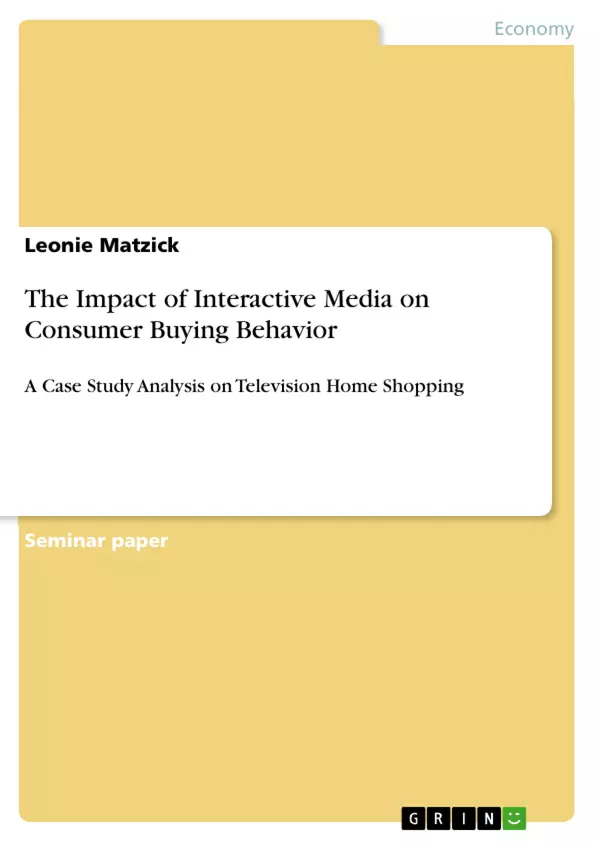In Germany, the market for home shopping is booming. Television constantly gains importance for direct marketing activities. In 2000 the turnover of Germany’s three most successful television home shopping companies Home Shopping Europe (HSE), QVC and RTL Shop reached a total of €392 million; in 2004 it increased to approximately €871 million. Today, statistically speaking every sixth German has ordered a product or service from a television home shopping channel, 5,6 million of them even do it on a regular basis.
Television home shopping today gains €1,2 billion and the market research institution Goldmedia in Berlin expects a €1,6 billion turnover until 2012. The television home shopping companies achieve better results than they had ever before. The company QVC, based in Düsseldorf increased its turnover in the last year and achieved its second best result since its formation twelve years ago. The television home shopping channel 1-2-3.tv GmbH currently closed its business year with the best result since its formation four years ago and the market is not saturated yet.
This market situation leads to the fact that in spite of the economical crisis companies invest a lot of money in the development of home shopping. For example QVC plans to invest ten million Euros in 2009, mainly in developing Internet and IT-systems. In the past it has improved its logistics and achieved to shorten the delivery period to the customer by twenty percent.
Not only in Germany television home shopping is considered to be a growth market. In the United States the market for home shopping and mail order grew by 10% to a value of over US$172 billion in 2004. The European home shopping market grew from €67 billion in 2003 to more than €68 billion in 2004.
This paper deals with the question why television home shopping, as a part of interactive media, is so successful and what specific impact it has on the consumers’ buying patterns. This paper will concentrate on home-shopping channels. They will be analyzed exemplary, because above all shopping within these channels is one of the most interactive ways of home shopping and reveals some intriguing and interesting results concerning consumer manipulation techniques and consumer behavior.
The main objective is to find out why offering products and services via television has changed the consumers’ buying behavior until now and what can be expected for the future.
Inhaltsverzeichnis (Table of Contents)
- Introduction
- Definition
- Interactive Media
- Television Home Shopping
- Research Question and Objectives
- Course of Work
- Framework of Television Home Shopping
- Proceeding and Technique
- The Target Audience
- Analysis of Television Home Shopping
- Analysis of Success Factors
- Marketer's View
- Fit to the CRM Model
- Further Factors for Success
- Consumer's View
- Summary of the Results
- Future Prospects and Research
Zielsetzung und Themenschwerpunkte (Objectives and Key Themes)
This paper aims to investigate the reasons behind the success of television home shopping as a form of interactive media and analyze its impact on consumer buying patterns. The paper focuses specifically on television home shopping channels, considering them as a prime example of interactive home shopping. The primary objective is to understand why the offering of products and services through television has influenced consumer behavior and to explore future trends in this area.
- The definition and characteristics of interactive media, particularly television home shopping.
- The role of customer relationship management (CRM) in the success of television home shopping channels.
- The factors that influence consumer behavior and buying patterns when it comes to television home shopping.
- The analysis of the success factors from both the marketer's and the consumer's perspective.
- The future prospects and research opportunities in the field of television home shopping.
Zusammenfassung der Kapitel (Chapter Summaries)
- Introduction: This chapter provides a comprehensive definition of interactive media and television home shopping. It explores different perspectives on direct marketing and highlights the importance of customer interaction and relationship building in modern marketing strategies.
- Framework of Television Home Shopping: This chapter delves into the mechanics of television home shopping, examining the buying process, techniques employed to encourage purchases, and the characteristics of typical target audiences. The chapter emphasizes the importance of understanding customer needs and preferences in this specific marketing context.
- Analysis of Television Home Shopping: This chapter explores the key factors contributing to the success of television home shopping, focusing on both marketer's and consumer's perspectives. The chapter examines how the CRM model is successfully applied to television home shopping and analyzes the specific factors that influence consumer buying decisions. It further investigates the advantages of television home shopping compared to traditional retail shopping.
Schlüsselwörter (Keywords)
The main focus of this paper lies in the analysis of television home shopping as a form of interactive media, particularly emphasizing its success factors and impact on consumer behavior. Key terms include: interactive media, direct marketing, television home shopping, customer relationship management (CRM), consumer behavior, buying patterns, and marketing strategies.
- Citar trabajo
- Leonie Matzick (Autor), 2009, The Impact of Interactive Media on Consumer Buying Behavior, Múnich, GRIN Verlag, https://www.grin.com/document/157095



